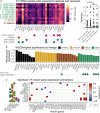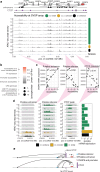Diverse Gene Regulatory Mechanisms Alter Rattlesnake Venom Gene Expression at Fine Evolutionary Scales
- PMID: 38753011
- PMCID: PMC11243404
- DOI: 10.1093/gbe/evae110
Diverse Gene Regulatory Mechanisms Alter Rattlesnake Venom Gene Expression at Fine Evolutionary Scales
Abstract
Understanding and predicting the relationships between genotype and phenotype is often challenging, largely due to the complex nature of eukaryotic gene regulation. A step towards this goal is to map how phenotypic diversity evolves through genomic changes that modify gene regulatory interactions. Using the Prairie Rattlesnake (Crotalus viridis) and related species, we integrate mRNA-seq, proteomic, ATAC-seq and whole-genome resequencing data to understand how specific evolutionary modifications to gene regulatory network components produce differences in venom gene expression. Through comparisons within and between species, we find a remarkably high degree of gene expression and regulatory network variation across even a shallow level of evolutionary divergence. We use these data to test hypotheses about the roles of specific trans-factors and cis-regulatory elements, how these roles may vary across venom genes and gene families, and how variation in regulatory systems drive diversity in venom phenotypes. Our results illustrate that differences in chromatin and genotype at regulatory elements play major roles in modulating expression. However, we also find that enhancer deletions, differences in transcription factor expression, and variation in activity of the insulator protein CTCF also likely impact venom phenotypes. Our findings provide insight into the diversity and gene-specificity of gene regulatory features and highlight the value of comparative studies to link gene regulatory network variation to phenotypic variation.
Keywords: ATAC-seq; CTCF; chromatin; cis-regulatory element; enhancer; gene regulatory networks.
© The Author(s) 2024. Published by Oxford University Press on behalf of Society for Molecular Biology and Evolution.
Figures






Similar articles
-
The Tiger Rattlesnake genome reveals a complex genotype underlying a simple venom phenotype.Proc Natl Acad Sci U S A. 2021 Jan 26;118(4):e2014634118. doi: 10.1073/pnas.2014634118. Proc Natl Acad Sci U S A. 2021. PMID: 33468678 Free PMC article.
-
The origins and evolution of chromosomes, dosage compensation, and mechanisms underlying venom regulation in snakes.Genome Res. 2019 Apr;29(4):590-601. doi: 10.1101/gr.240952.118. Epub 2019 Mar 21. Genome Res. 2019. PMID: 30898880 Free PMC article.
-
The genesis of an exceptionally lethal venom in the timber rattlesnake (Crotalus horridus) revealed through comparative venom-gland transcriptomics.BMC Genomics. 2013 Jun 12;14:394. doi: 10.1186/1471-2164-14-394. BMC Genomics. 2013. PMID: 23758969 Free PMC article.
-
A Review of Rattlesnake Venoms.Toxins (Basel). 2023 Dec 19;16(1):2. doi: 10.3390/toxins16010002. Toxins (Basel). 2023. PMID: 38276526 Free PMC article. Review.
-
Intraspecific gene regulation in cis- and trans.Evolution. 2025 Apr 2;79(4):499-509. doi: 10.1093/evolut/qpaf014. Evolution. 2025. PMID: 39866040 Review.
References
MeSH terms
Substances
LinkOut - more resources
Full Text Sources
Molecular Biology Databases

